牛津译林版(2019)选择性必修 第一册Unit 1 Food matters中华美食课件(共23张PPT)
文档属性
| 名称 | 牛津译林版(2019)选择性必修 第一册Unit 1 Food matters中华美食课件(共23张PPT) | 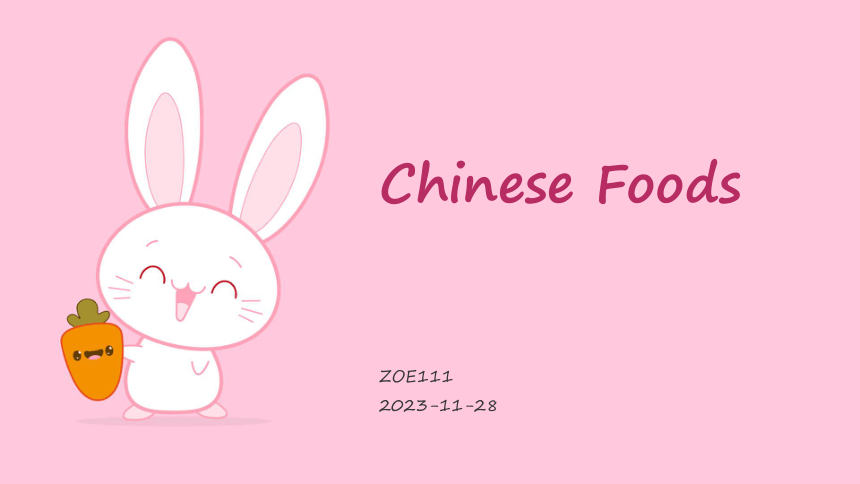 | |
| 格式 | pptx | ||
| 文件大小 | 1.8MB | ||
| 资源类型 | 教案 | ||
| 版本资源 | 牛津译林版(2019) | ||
| 科目 | 英语 | ||
| 更新时间 | 2023-11-28 20:15:02 | ||
图片预览

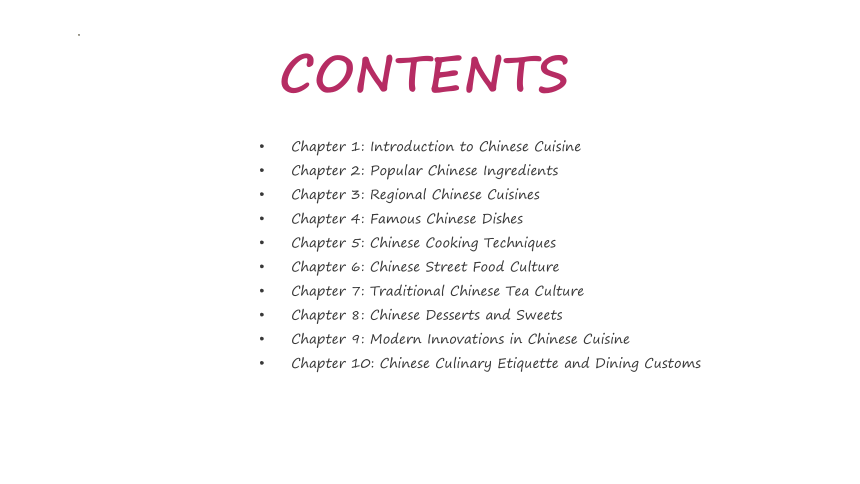
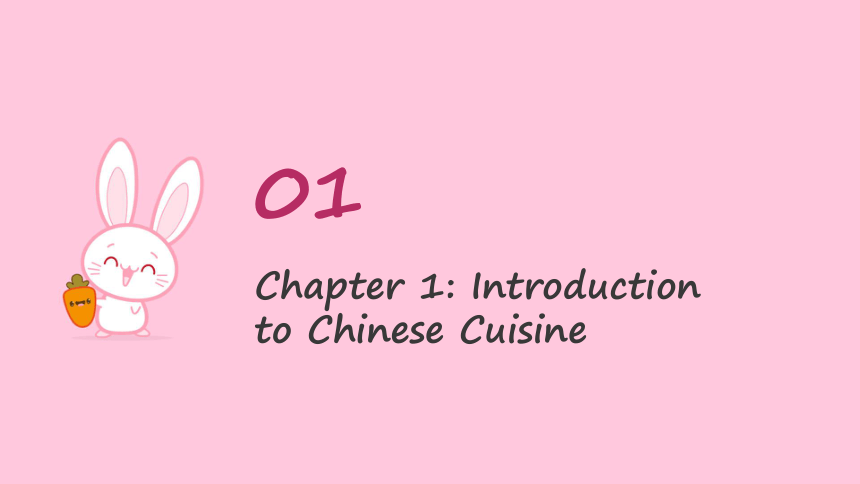
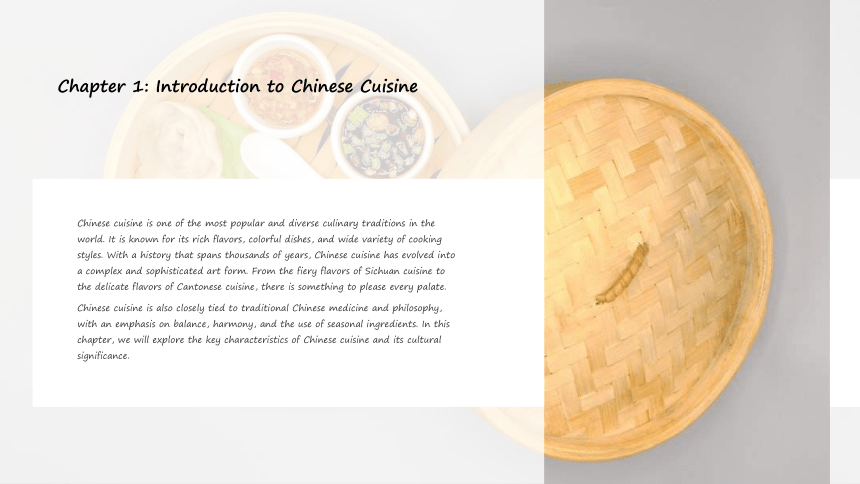


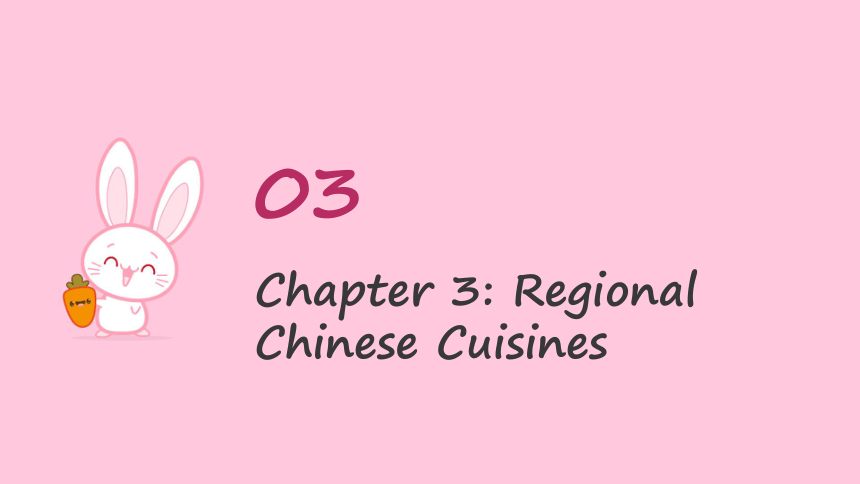
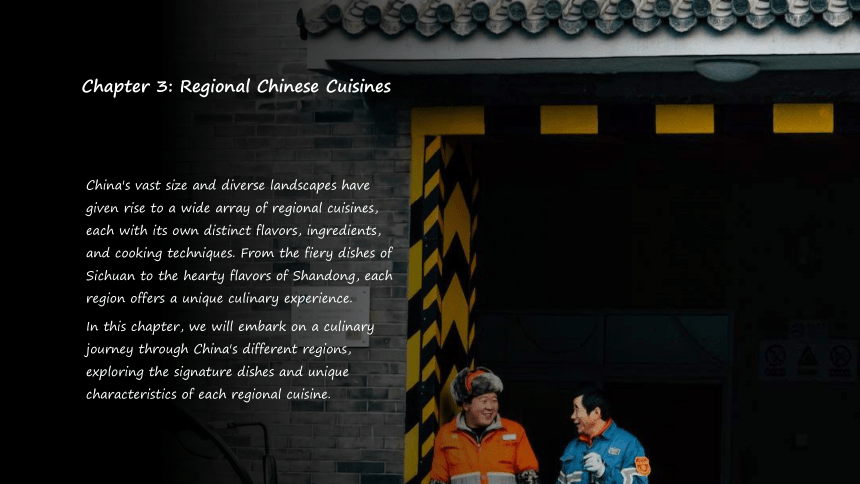
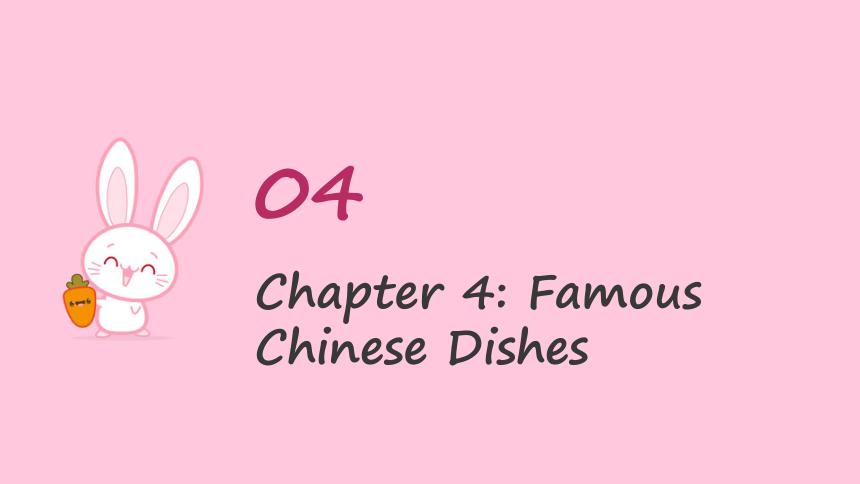
文档简介
(共23张PPT)
Chinese Foods
ZOE111
2023-11-28
CONTENTS
Chapter 1: Introduction to Chinese Cuisine
Chapter 2: Popular Chinese Ingredients
Chapter 3: Regional Chinese Cuisines
Chapter 4: Famous Chinese Dishes
Chapter 5: Chinese Cooking Techniques
Chapter 6: Chinese Street Food Culture
Chapter 7: Traditional Chinese Tea Culture
Chapter 8: Chinese Desserts and Sweets
Chapter 9: Modern Innovations in Chinese Cuisine
Chapter 10: Chinese Culinary Etiquette and Dining Customs
01
Chapter 1: Introduction to Chinese Cuisine
Chapter 1: Introduction to Chinese Cuisine
Chinese cuisine is one of the most popular and diverse culinary traditions in the world. It is known for its rich flavors, colorful dishes, and wide variety of cooking styles. With a history that spans thousands of years, Chinese cuisine has evolved into a complex and sophisticated art form. From the fiery flavors of Sichuan cuisine to the delicate flavors of Cantonese cuisine, there is something to please every palate.
Chinese cuisine is also closely tied to traditional Chinese medicine and philosophy, with an emphasis on balance, harmony, and the use of seasonal ingredients. In this chapter, we will explore the key characteristics of Chinese cuisine and its cultural significance.
02
Chapter 2: Popular Chinese Ingredients
Chapter 2: Popular Chinese Ingredients
The ingredients used in Chinese cooking are as diverse as the cuisine itself. From the pungent aroma of ginger and garlic to the umami-rich flavors of soy sauce and oyster sauce, Chinese ingredients add depth and complexity to dishes. Staples such as rice, noodles, and tofu are integral to Chinese cooking, while exotic ingredients like century eggs and dried sea cucumbers provide a glimpse into the adventurous nature of Chinese cuisine.
In this chapter, we will take a closer look at some of the most popular and essential ingredients in Chinese cooking, exploring their flavors, uses, and cultural significance.
03
Chapter 3: Regional Chinese Cuisines
Chapter 3: Regional Chinese Cuisines
China's vast size and diverse landscapes have given rise to a wide array of regional cuisines, each with its own distinct flavors, ingredients, and cooking techniques. From the fiery dishes of Sichuan to the hearty flavors of Shandong, each region offers a unique culinary experience.
In this chapter, we will embark on a culinary journey through China's different regions, exploring the signature dishes and unique characteristics of each regional cuisine.
04
Chapter 4: Famous Chinese Dishes
Chapter 4: Famous Chinese Dishes
Chinese cuisine is celebrated for its iconic dishes, many of which have gained global recognition. From the crispy and fragrant Peking duck to the savory and spicy mapo tofu, these dishes showcase the diversity and complexity of Chinese cooking.
In this chapter, we will delve into the origins and preparation of some of the most famous Chinese dishes, offering insights into the techniques and flavors that make them so beloved.
05
Chapter 5: Chinese Cooking Techniques
Chapter 5: Chinese Cooking Techniques
Chinese cooking is characterized by a diverse range of cooking techniques, including stir-frying, steaming, braising, and deep-frying. Each technique is carefully designed to preserve the natural flavors and textures of the ingredients, resulting in dishes that are both delicious and nutritious.
In this chapter, we will explore the key cooking techniques used in Chinese cuisine, examining their unique advantages and the best dishes to showcase their effectiveness.
06
Chapter 6: Chinese Street Food Culture
Chapter 6: Chinese Street Food Culture
Chinese street food culture is a vibrant and integral part of the culinary landscape. From bustling night markets to roadside stalls, the aromas of sizzling skewers and steaming dumplings fill the air, offering a tantalizing array of snacks and quick bites.
In this chapter, we will take a closer look at the dynamic world of Chinese street food, celebrating the diverse flavors and culinary creativity found in this bustling culinary scene.
07
Chapter 7: Traditional Chinese Tea Culture
Chapter 7: Traditional Chinese Tea Culture
In Chinese culture, tea is more than just a beverage – it is a way of life. Traditional Chinese tea culture has a long and storied history, with intricate ceremonies and rituals that celebrate the art of tea making and drinking. From delicate green teas to robust oolongs, tea plays a central role in Chinese gastronomy.
In this chapter, we will explore the rich and vibrant traditions of Chinese tea culture, shedding light on the varieties of tea, brewing methods, and the significance of tea in Chinese cuisine and daily life.
08
Chapter 8: Chinese Desserts and Sweets
Chapter 8: Chinese Desserts and Sweets
Chinese desserts are a delightful and often overlooked part of the country's culinary repertoire. From delicate pastries to sweet rice dumplings, Chinese desserts offer a wide range of textures and flavors that are the perfect conclusion to a satisfying meal.
In this chapter, we will indulge in the delectable world of Chinese desserts, exploring the unique ingredients and cultural influences that shape these sweet treats.
09
Chapter 9: Modern Innovations in Chinese Cuisine
Chapter 9: Modern Innovations in Chinese Cuisine
While Chinese cuisine boasts a rich and enduring culinary tradition, it also continues to evolve and innovate. From avant-garde fusion dishes to innovative cooking technologies, modern Chinese chefs are pushing the boundaries of tradition and creativity.
In this chapter, we will examine the contemporary landscape of Chinese cuisine, highlighting the innovative trends and culinary experiments that are shaping the future of Chinese gastronomy.
10
Chapter 10: Chinese Culinary Etiquette and Dining Customs
Chapter 10: Chinese Culinary Etiquette and Dining Customs
The dining experience in China is imbued with centuries of tradition and etiquette, from the art of serving tea to the proper way of using chopsticks. Understanding and respecting these customs is key to fully appreciating the rich tapestry of Chinese culinary culture.
In this final chapter, we will delve into the nuances of Chinese culinary etiquette and dining customs, offering insights into the rituals and practices that enhance the enjoyment of Chinese cuisine.
THE END
THANKS
Chinese Foods
ZOE111
2023-11-28
CONTENTS
Chapter 1: Introduction to Chinese Cuisine
Chapter 2: Popular Chinese Ingredients
Chapter 3: Regional Chinese Cuisines
Chapter 4: Famous Chinese Dishes
Chapter 5: Chinese Cooking Techniques
Chapter 6: Chinese Street Food Culture
Chapter 7: Traditional Chinese Tea Culture
Chapter 8: Chinese Desserts and Sweets
Chapter 9: Modern Innovations in Chinese Cuisine
Chapter 10: Chinese Culinary Etiquette and Dining Customs
01
Chapter 1: Introduction to Chinese Cuisine
Chapter 1: Introduction to Chinese Cuisine
Chinese cuisine is one of the most popular and diverse culinary traditions in the world. It is known for its rich flavors, colorful dishes, and wide variety of cooking styles. With a history that spans thousands of years, Chinese cuisine has evolved into a complex and sophisticated art form. From the fiery flavors of Sichuan cuisine to the delicate flavors of Cantonese cuisine, there is something to please every palate.
Chinese cuisine is also closely tied to traditional Chinese medicine and philosophy, with an emphasis on balance, harmony, and the use of seasonal ingredients. In this chapter, we will explore the key characteristics of Chinese cuisine and its cultural significance.
02
Chapter 2: Popular Chinese Ingredients
Chapter 2: Popular Chinese Ingredients
The ingredients used in Chinese cooking are as diverse as the cuisine itself. From the pungent aroma of ginger and garlic to the umami-rich flavors of soy sauce and oyster sauce, Chinese ingredients add depth and complexity to dishes. Staples such as rice, noodles, and tofu are integral to Chinese cooking, while exotic ingredients like century eggs and dried sea cucumbers provide a glimpse into the adventurous nature of Chinese cuisine.
In this chapter, we will take a closer look at some of the most popular and essential ingredients in Chinese cooking, exploring their flavors, uses, and cultural significance.
03
Chapter 3: Regional Chinese Cuisines
Chapter 3: Regional Chinese Cuisines
China's vast size and diverse landscapes have given rise to a wide array of regional cuisines, each with its own distinct flavors, ingredients, and cooking techniques. From the fiery dishes of Sichuan to the hearty flavors of Shandong, each region offers a unique culinary experience.
In this chapter, we will embark on a culinary journey through China's different regions, exploring the signature dishes and unique characteristics of each regional cuisine.
04
Chapter 4: Famous Chinese Dishes
Chapter 4: Famous Chinese Dishes
Chinese cuisine is celebrated for its iconic dishes, many of which have gained global recognition. From the crispy and fragrant Peking duck to the savory and spicy mapo tofu, these dishes showcase the diversity and complexity of Chinese cooking.
In this chapter, we will delve into the origins and preparation of some of the most famous Chinese dishes, offering insights into the techniques and flavors that make them so beloved.
05
Chapter 5: Chinese Cooking Techniques
Chapter 5: Chinese Cooking Techniques
Chinese cooking is characterized by a diverse range of cooking techniques, including stir-frying, steaming, braising, and deep-frying. Each technique is carefully designed to preserve the natural flavors and textures of the ingredients, resulting in dishes that are both delicious and nutritious.
In this chapter, we will explore the key cooking techniques used in Chinese cuisine, examining their unique advantages and the best dishes to showcase their effectiveness.
06
Chapter 6: Chinese Street Food Culture
Chapter 6: Chinese Street Food Culture
Chinese street food culture is a vibrant and integral part of the culinary landscape. From bustling night markets to roadside stalls, the aromas of sizzling skewers and steaming dumplings fill the air, offering a tantalizing array of snacks and quick bites.
In this chapter, we will take a closer look at the dynamic world of Chinese street food, celebrating the diverse flavors and culinary creativity found in this bustling culinary scene.
07
Chapter 7: Traditional Chinese Tea Culture
Chapter 7: Traditional Chinese Tea Culture
In Chinese culture, tea is more than just a beverage – it is a way of life. Traditional Chinese tea culture has a long and storied history, with intricate ceremonies and rituals that celebrate the art of tea making and drinking. From delicate green teas to robust oolongs, tea plays a central role in Chinese gastronomy.
In this chapter, we will explore the rich and vibrant traditions of Chinese tea culture, shedding light on the varieties of tea, brewing methods, and the significance of tea in Chinese cuisine and daily life.
08
Chapter 8: Chinese Desserts and Sweets
Chapter 8: Chinese Desserts and Sweets
Chinese desserts are a delightful and often overlooked part of the country's culinary repertoire. From delicate pastries to sweet rice dumplings, Chinese desserts offer a wide range of textures and flavors that are the perfect conclusion to a satisfying meal.
In this chapter, we will indulge in the delectable world of Chinese desserts, exploring the unique ingredients and cultural influences that shape these sweet treats.
09
Chapter 9: Modern Innovations in Chinese Cuisine
Chapter 9: Modern Innovations in Chinese Cuisine
While Chinese cuisine boasts a rich and enduring culinary tradition, it also continues to evolve and innovate. From avant-garde fusion dishes to innovative cooking technologies, modern Chinese chefs are pushing the boundaries of tradition and creativity.
In this chapter, we will examine the contemporary landscape of Chinese cuisine, highlighting the innovative trends and culinary experiments that are shaping the future of Chinese gastronomy.
10
Chapter 10: Chinese Culinary Etiquette and Dining Customs
Chapter 10: Chinese Culinary Etiquette and Dining Customs
The dining experience in China is imbued with centuries of tradition and etiquette, from the art of serving tea to the proper way of using chopsticks. Understanding and respecting these customs is key to fully appreciating the rich tapestry of Chinese culinary culture.
In this final chapter, we will delve into the nuances of Chinese culinary etiquette and dining customs, offering insights into the rituals and practices that enhance the enjoyment of Chinese cuisine.
THE END
THANKS
同课章节目录
- Unit 1 Food matters
- Welcome to the unit
- Reading
- Grammar and usage
- Integrated skills
- Extended reading
- Project
- Unit 2 The Universal Language
- Welcome to the unit
- Reading
- Grammar and usage
- Integrated skills
- Extended reading
- Project
- Unit 3 The art of painting
- Welcome to the unit
- Reading
- Grammar and usage
- Integrated skills
- Extended reading
- Project
- Unit 4 Exploring poetry
- Welcome to the unit
- Reading
- Grammar and usage
- Integrated skills
- Extended reading
- Project
